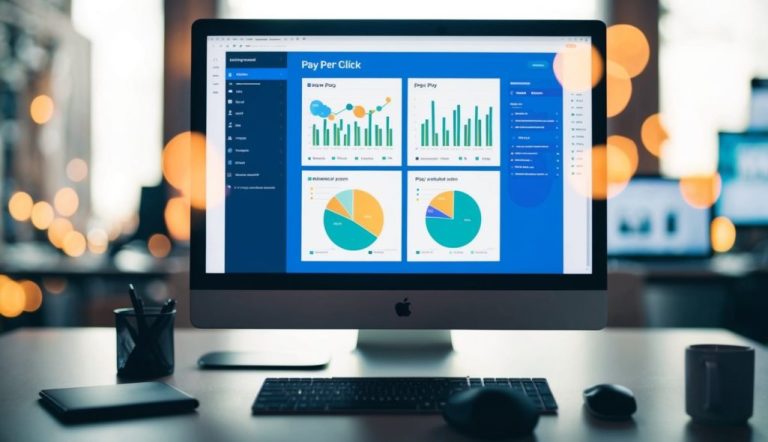Pay-per-click (PPC) advertising is a powerful way to earn money online. It might seem challenging at first, but with the right tools and strategies, you can turn PPC into a reliable income stream.
To make money with PPC, you need to focus on creating campaigns that attract the right audience and optimize them to increase both traffic and revenue.

You’ll discover the secrets to setting up and maintaining efficient PPC campaigns. Different platforms like Google Ads and Facebook offer unique opportunities, and it’s important to choose those that match your goals.
By understanding how to target the right demographics, you ensure your ads reach people who are most likely to engage.
Tracking performance and refining your strategy are crucial for sustained success in PPC advertising. Regularly analyzing data helps you increase your return on investment and adjust for better outcomes.
Key Takeaways
- Focus on choosing the right PPC platforms and targeting the correct audience.
- Regularly analyze and optimize your campaigns to maximize ROI.
- Understanding your audience and platforms leads to PPC success.
Understanding Pay-Per-Click
Pay-Per-Click (PPC) advertising lets you pay only when your ad gets a click, making it a cost-effective tool for driving traffic. This method offers different pricing models to suit your specific business goals.
Basics of PPC
PPC is a digital ad model where you pay every time someone clicks your ad, which helps increase web traffic. When running PPC campaigns, you create ads aimed at your target audience. The payment is based on the number of clicks your ad receives. This makes the cost predictable and manageable.
Two common PPC pricing strategies are CPC (Cost Per Click) and CPM (Cost Per Thousand Impressions). With CPC, you pay each time your ad is clicked. In a CPM model, you pay for every 1,000 times your ad is shown, but not necessarily clicked.
Both ways help bring visitors to your site without waiting for organic search rankings. Understanding these basics allows better strategy choices for your business needs.
Different Models of PPC
PPC uses several models to meet different advertising needs. Besides CPC and CPM, another option is CPA (Cost Per Acquisition). With CPA, you pay when a user takes a specific action, like making a purchase.
CPC focuses on getting traffic by paying per click, which suits increasing visits. CPM works when brand visibility is the aim since it charges for impressions. CPA is often used to maximize conversions, ensuring payment only when the desired outcome occurs.
Depending on your goals, you might choose different PPC models. Each has unique advantages, so knowing them can enhance your campaign effectiveness and budget efficiency.
Setting Up for PPC Success
To get the most out of pay-per-click (PPC) advertising, choosing the right niche, finding relevant keywords, and writing ad copy are key steps. Each part is important in making sure your ads reach the right audience and bring in profit.
Choosing a Profitable Niche
Picking a profitable niche is the first step to PPC success. Focus on areas where demand is high but competition isn’t overwhelming. Look for trends in consumer interest and gaps in the market.
Tools like Google Trends can help identify these opportunities. Consider the profitability by assessing the average cost-per-click (CPC) and potential return on investment (ROI). Your niche should have enough search volume to support ongoing campaigns. Evaluating competitors’ strategies can also offer insight into market potential.
Conducting Keyword Research
Keyword research is essential to identify search terms your audience uses. Start with tools like Google Keyword Planner to find relevant keywords. Focus on long-tail keywords as they often have less competition and higher conversion rates.
Make a list of potential keywords and analyze their search volume, competition, and estimated CPC. Group keywords by themes related to your niche. Regularly updating your keyword list based on performance data helps maintain ad relevance and effectiveness. Understanding search intent behind keywords further refines targeting strategies.
Creating Compelling Ad Copy
Your ad copy should grab attention and motivate clicks. Highlight key benefits and include a strong call-to-action (CTA). Make sure the ad copy aligns with the keywords and the landing page content to ensure ad relevance.
| Dos | Don’ts |
| — | — |
| Use concise language | Avoid jargon |
| Focus on benefits | Don’t be vague |
Use ad extensions like site links and call buttons to provide more information and encourage engagement. Testing different versions of ad copy (A/B testing) helps identify what resonates best with your audience. Consistent monitoring and tweaking can lead to better click-through rates and conversions.
By focusing on these elements, you can set up a successful PPC campaign that reaches the right audience and maximizes return.
Selecting the Right PPC Platforms
Choosing the right PPC platform is crucial for maximizing earnings and reaching the right audience. Evaluating different platforms and affiliate programs will help you determine the best fit for your goals and target market.
Overview of PPC Platforms
PPC platforms offer various features and demographics to help you reach specific audiences. Google Ads is one of the most popular choices due to its vast reach. This platform allows you to target specific locations and interests, making it a versatile option.
Other platforms like Media.net and Infolinks specialize in contextual advertising and can be ideal if you’re looking to focus on specific types of content. Ezoic and Mediavine are excellent for content-rich sites, providing a user-friendly interface and strong support systems. These platforms often offer a wide range of ad formats, including display and native ads, to suit different needs.
Consider platforms like AdThrive and Skimlinks if you have a large audience and want premium ad solutions. They require higher traffic thresholds but offer advanced monetization options. This diverse range of platforms can help you find the right audience match.
Comparing PPC Affiliate Programs
When comparing PPC affiliate programs, consider the payout structure and support. Google AdSense is well-known for its reliability and comprehensive reporting tools, offering multiple ad format options. It’s suitable for beginners looking to monetize their content easily.
Programs like Media.net also stand out, providing access to Yahoo and Bing’s network which can be beneficial if you seek alternatives to Google. Ezoic offers machine learning tools to optimize earnings over time, making them appealing for those focusing on traffic growth.
AdThrive and Mediavine require higher traffic but reward with higher payouts due to their premium advertising partners. Evaluate each program’s requirements and fees to determine which offers the best potential earnings and audience reach for your platform.
Optimizing for Audience and Traffic
To maximize success with pay-per-click (PPC) advertising, it’s important to understand and target the right audience and drive the right kind of traffic. This involves crafting campaigns that align with user preferences and behaviors.
Understanding Your Audience
Knowing your audience is crucial. Begin by analyzing demographics, interests, and behaviors. Use tools like Google Analytics to gather data about age, gender, location, and devices used by your visitors. This helps in creating personas which make your campaigns more relatable.
Consider the customer journey. Are your users looking for information, ready to make a purchase, or seeking customer support? Tailor your ads to match these stages. A/B testing can reveal what language and design work best for different groups, helping you refine your approach.
Studying your competition is also useful. Find out who their audiences are and see where they overlap with yours. Look at their ad strategies and learn from what works or doesn’t. Use audience insights to target potential users and keep existing ones engaged.
Building Targeted Traffic
Targeted traffic means attracting visitors who are likely to convert. Start by using specific keywords that match your ads with search queries. Using long-tail keywords ensures that you attract users with high intent.
Focus on platforms that your audience frequents. Platforms like Facebook, Instagram, and Google Ads offer detailed targeting options to reach the right users. Set precise parameters, such as interests or purchasing behaviors, to narrow down your audience.
Enhance user experience once they land on your site. A seamless user experience increases conversion rates. Ensure that your landing pages load quickly and are user-friendly. Monitor unique visitors and measure how many convert versus bounce. Continuous optimization based on real-time data helps maintain effective traffic flow.
Enhancing PPC Campaigns
To improve the effectiveness of PPC campaigns, focus on using analytics tools and conducting A/B testing. These strategies are vital for optimizing factors like conversion rate and click-through rate (CTR).
Leveraging Analytics Tools
Analytics tools are crucial for tracking the performance of your PPC campaigns. By monitoring metrics like CTR and conversion rates, you can gain valuable insights into what’s working and what needs improvement. Tools such as Google Analytics or Adobe Analytics allow you to see where your traffic comes from and how users interact with your ads and landing pages.
Creating dashboards with these tools helps you visualize data and spot trends over time. Conversion funnels are particularly useful for understanding where potential customers drop off. Regularly reviewing these analytics ensures you can make informed decisions that enhance campaign performance. For more insight into PPC, visit this comprehensive guide.
A/B Testing and Adjustment
A/B testing involves comparing two versions of an ad or landing page to see which performs better. This helps you refine elements like headlines, images, or call-to-action buttons. By systematically testing these components, you can increase your CTR and conversion rate.
Start by changing one element at a time to isolate what impacts your results. Maintain a clear record of each test to avoid confusion. Monitor performance metrics closely and adjust based on data-driven results. A/B testing is an ongoing process that helps in continuously optimizing your PPC efforts. Using this iterative approach can ultimately lead to improved campaign outcomes. Check out this article for detailed strategies on PPC marketing.
Monetization Strategies
To make money with pay-per-click (PPC), you can use strategies like affiliate marketing and ad networks. These methods can help you earn income by promoting products or displaying ads on your website.
Affiliate Marketing Techniques
Affiliate marketing is a great way to earn money. You can do this by joining affiliate programs that let you promote products or services. Each time someone clicks your affiliate link and makes a purchase, you earn a commission.
Building a strong online presence is key. This involves creating high-quality content that attracts visitors to your site. When you integrate affiliate links naturally into your content, you provide value to your readers and increase your chances of earning more.
Joining popular affiliate networks can expand your earning opportunities. Networks like Amazon Associates or ClickBank offer a variety of products that you can promote to your audience. By carefully choosing the right products for your niche, you can maximize your affiliate income.
Earning Through Ad Networks
Ad networks connect advertisers with publishers, allowing you to earn revenue by displaying ads on your website. Two notable types of ads are display ads and text ads. While display ads are often image-based, text ads are composed of words only.
Google AdSense is one of the most popular ad networks that allows you to generate ad revenue by placing relevant ads on your website. When visitors click these ads, you earn money. To make the most of it, you should focus on increasing your website traffic.
Another option is BuySellAds, which connects you with advertisers looking for space on popular websites. By using ad networks effectively, you can increase your earnings and ensure a steady stream of income.
Measuring and Maximizing ROI
To make the most out of your pay-per-click campaigns, it’s essential to focus on measuring your return on investment (ROI) and optimizing for cost-efficiency and revenue generation. We’ll look at how to calculate ROI and explore strategies to maximize your profits.
Calculating PPC Return on Investment
Calculating ROI for your PPC campaigns is crucial for evaluating their success. The standard formula is:
[ \text{ROI} = \left(\frac{\text{Revenue} – \text{Cost of Ads}}{\text{Cost of Ads}}\right) \times 100 ]
For example, if you spend $500 on ads and make $1,000 in revenue, your ROI is 100%. This means you’ve doubled your investment. Understanding this metric helps you see which campaigns are most profitable.
Tracking ROI is not just about immediate returns. Consider long-term effects like increased brand recognition or customer retention. This broader view can provide a more comprehensive understanding of your campaign’s value. Tools like RevenueHits and Adsterra can help you monitor these metrics effectively.
Cost-Efficiency and Profit Maximization
To maximize profits, focus on cost-efficiency in your PPC campaigns. This involves optimizing ad spend and selecting the right keywords to target. Using data from reputable sources like RevenueHits helps in choosing high-performing keywords that have low competition and high conversion rates.
Implementing a revenue share model with partners can also boost your income. You share the profits from sales generated by your ads, effectively doubling your market reach without additional costs. Monitoring EPMV (Earnings Per Thousand Visitors) gives insights into how well your ads are performing in terms of profit per visitor, guiding further adjustments for maximum gains.
Advanced PPC Techniques
In the realm of pay-per-click (PPC) advertising, adopting advanced strategies can significantly improve outcomes. These include optimizing the user experience on landing pages, navigating competition effectively, and using a mix of ad types for greater impact.
Landing Pages and User Experience
Your landing pages play a crucial role in PPC success. A well-designed page not only boosts conversions but also enhances user experience. Focus on making your landing pages fast, mobile-friendly, and visually appealing. Use clear and concise language to maintain visitor interest.
Incorporate search engine optimization (SEO) elements, such as targeted keywords, to improve your landing page visibility. Include strong calls-to-action (CTAs) that guide users toward desired actions. A/B testing different versions of your landing pages can reveal insights into what converts best. Take these steps seriously to maximize your PPC investment.
Navigating the Competitive Landscape
Staying ahead in PPC advertising means outsmarting your competition. Analyzing competitors’ ads can give you an edge. Understand their keywords, ad copy, and bidding strategies. Use tools like Google Ads’ Auction Insights to evaluate your position relative to competitors.
It’s critical to monitor the market trends and adjust your strategies accordingly. For instance, if a competitor is using a certain type of ad, evaluate if it’s something you should consider. Keep adapting and innovating to maintain relevancy and attract more clicks.
Diversifying Through Multiple Ad Types
Diversifying your ad types is essential. It allows you to reach different audience segments effectively. Consider running display ads for visual appeal, native ads for seamless integration with content, and video ads for engaging storytelling.
As a content creator, this diversity not only broadens your reach but also improves your overall ad campaign performance. Different platforms might favor different ad formats, so understanding where your audience spends time can guide your ad placement. Balance your efforts across these ad types to ensure a strong presence in the digital space.
Challenges and Solutions in PPC
Pay-per-click (PPC) advertising can boost brand awareness and generate leads, but it comes with challenges. Click fraud and optimizing strategies for sales are critical issues to address effectively. Understanding these areas helps in maintaining a successful PPC campaign.
Dealing with Click Fraud
Click fraud is when invalid clicks on ads are made with the intent to drain your budget. This problem affects the return on your ad spend significantly. To tackle this, use advanced monitoring tools that can detect suspicious activities. Setting up IP exclusions for known offenders is another effective method. This will help protect your budget.
Regularly reviewing your click data is essential. Look for unusual spikes or patterns that might indicate fraud. Increasing awareness of how click fraud happens can help you better recognize threats.
A proactive approach can safeguard your campaign from wasting money on fraudulent clicks, enhancing your overall PPC performance.
Strategies for Increasing Sales and Leads
Focusing on the right strategies can boost your sales and increase the number of leads your campaign generates. Start with refining your keyword strategy. Use long-tail keywords to attract more qualified traffic. This often results in higher conversion rates.
Another crucial aspect is improving your ad copy and landing pages. A/B testing your ads can help determine what resonates best with your audience. Make sure your landing pages are optimized for conversions by having clear calls to action and keeping the design user-friendly.
To expand reach and effectiveness, diversify your ad platforms. Using both search and display ads can significantly enhance brand awareness and generate quicker results. Employing these strategies can markedly increase both sales and lead generation.
Expanding Beyond Traditional PPC
Diving into new avenues of PPC involves exploring platforms like social media and mobile applications. These channels offer unique opportunities to reach target audiences where they spend their time, which can enhance your advertising efforts.
Exploring Social Media Advertising
Social media platforms such as Facebook provide dynamic environments for advertising. With Facebook Ads, you can target users based on demographics, interests, and online behaviors. This allows for highly personalized ads, increasing the chance of engagement.
YouTube AdSense is another powerful tool, enabling video ads that can capture attention more effectively than text alone. Video content often leads to higher engagement rates. Microsoft Advertising offers an additional platform by integrating with LinkedIn, allowing access to professional demographics for business-oriented campaigns.
Using these platforms can diversify and strengthen your advertising strategies. They each offer unique features such as retargeting and custom audiences to improve campaign performance.
Engaging with Mobile and App Advertising
Mobile advertising has seen significant growth with the increase in smartphone usage. Advertising in mobile applications allows you to reach users directly in the apps they’re using, capturing their attention while they’re engaged. Platforms like AdBlade and BidVertiser specialize in mobile ads, offering a variety of formats to suit your needs.
App ads often come in interactive formats that can greatly increase user engagement. Since people spend a lot of time on their phones, reaching them through apps is key. Targeting on mobile ensures access to audiences using mobile devices extensively throughout the day.
Investing in mobile advertising can lead to effective reach and engagement by tapping into this rapidly growing segment.
Creating a Sustainable PPC Business
Building a sustainable Pay Per Click (PPC) business requires careful planning and resilience in your revenue models. You need to focus on strategic growth and diversifying income streams while keeping a close eye on trends in digital marketing.
Long-Term PPC Planning and Growth
A key part of sustaining a PPC business is strategic planning for growth. Start by evaluating search volume for high-impact keywords. This helps you target ads effectively. Data tools like Google Keyword Planner can guide you in this process.
Effective budget allocation is vital. Allocate funds wisely by focusing on campaigns that have shown high conversion rates. Regularly review and adapt your marketing strategies to ensure they align with current market trends and consumer behaviors.
Consider using platforms like Outbrain and RevenueHits to diversify your online advertising campaigns. These platforms can help you reach broader audiences with strategic ad placement.
Building a Resilient Revenue Model
Your revenue model should be diverse to withstand market fluctuations. Explore different advertising methods such as pay per impression and pay per lead (CPL). This can offer flexibility and greater stability.
Developing niche websites or affiliate websites can generate passive income from PPC. These sites can target specific audience groups with tailored content and ads.
Freelancing in PPC advertising is another possibility. Offer your expertise to businesses needing digital marketing services. This approach not only provides immediate income but also builds your reputation in the field.
Remaining adaptable and open to new digital marketing trends ensures your PPC business thrives.
Frequently Asked Questions
When it comes to making money with pay-per-click (PPC), understanding the basics, such as starting points and strategies, is crucial. You also need to recognize legitimate opportunities and learn the requirements to succeed in this field.
How can one start earning through pay-per-click websites?
To begin earning, you need to register on reputable PPC websites. Create accounts with platforms like Google Ads or Bing Ads. Set up your campaigns by carefully choosing keywords, crafting compelling ad copy, and setting a budget.
What are the highest paying pay-per-click affiliate programs available?
High-paying affiliate programs vary depending on the niche. Popular options include finance, insurance, and technology sectors. Look into platforms that partner with big brands, as these often offer higher rates per click due to the competitive industries involved.
What strategies can be employed to maximize earnings from pay-per-click advertising?
Targeting the right audience is key. Use precise keywords and optimize ads for mobile users. Regularly analyze the performance of your ads, adjusting them based on data insights. Testing different ad versions helps in determining the most effective approach.
Are there legitimate websites that pay for clicking on ads, and how to identify them?
Yes, platforms like ClickGUARD offer genuine opportunities. To identify legitimacy, check for positive reviews, secure payment methods, and transparent terms of service. Avoid sites with unrealistic earning promises.
How does pay-per-click advertising work for someone looking to generate income?
PPC involves businesses paying for each ad click, so advertisers run ads on search engines or social media platforms. This drives targeted traffic to their sites, generating income through increased conversions or sales.
What are the common requirements to start making money with pay-per-click online?
You’ll need a computer with internet access, a website, or landing page to direct traffic, and an account on a PPC platform. Some knowledge of digital marketing and analytics will help you optimize campaigns for better earnings.





